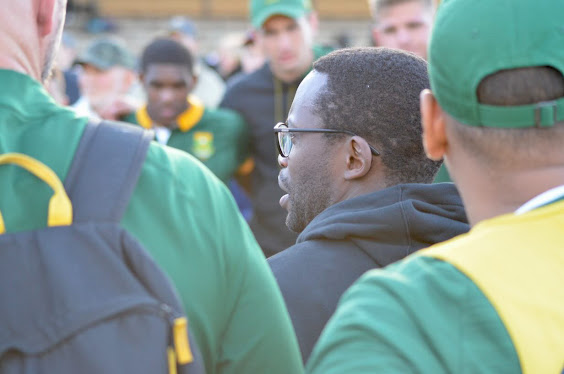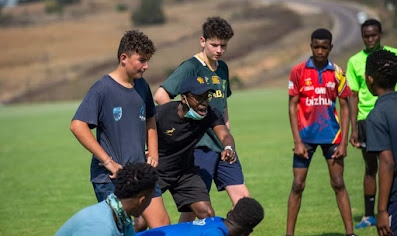Ireland tries vs Tonga and how the Boks can stop them
Round three awaits us this weekend as the Irish face off against the Springboks, a showdown between the world's top-ranked team and the second-ranked team. The winner of this clash will emerge as the leader of Pool C, staking a significant claim to this year's Rugby World Cup title.
Under the guidance of Andy Farrell, Ireland has undergone a transformation in their attacking prowess, displaying speed, execution, precision, and accuracy. Their ability to challenge defenses stems from playing on the gainline, maintaining a their structure, and possessing multiple threats surrounding their playmakers. Ireland's attack is versatile, capable of piercing through, maneuvering around, or soaring above opposition defenses, making them a formidable triple-threat team that's far from one-dimensional.
From a defensive perspective, it's crucial to thoroughly analyze their gameplay and devise strategies to disrupt their tempo and apply pressure on their playmakers. In the following discussion, we'll delve into specific tries from Ireland's match against Tonga, exploring what the Springboks can anticipate and how they plan to thwart Ireland's attacking prowess.
Ireland's Attack - Try 1
In this scenario, Ireland initiates a full lineout setup. They execute a well-coordinated play towards the middle, displaying remarkable width on the pass in their approach. One key aspect to note is the precision of Sexton's pass, which is delivered with excellent timing. Sexton's ability to run forward while staying square to the gainline is crucial here.
As Sexton advances, his movement engages the attention of four defenders, all of whom become fixated on him and the ball. This creates an opportunity for a pass back to the inside, a move that effectively evades the defenders pulled in by Sexton's presence. In this situation, all that remains is one more pass to secure the try.
Ireland's Attack - Try 2
In this instance, Ireland's attack takes on a more general form. They initiate the play by passing off the scrum-half to a forward pod, which carries the ball forward. Subsequently, they engage Sexton, who executes a cleverly designed sequence and delivers a pass out the back to Aki. Sexton has an option to play the switch which holds the defence, hardline but opts to play out the back to Aki, in turn, makes a play, opting to pass behind a decoy player.
The exceptional skill displayed here lies in their ability to release the ball to Hansen at the right moment, allowing him to execute the finishing touches for this remarkable try. Play the ball into space!
This image below shows their attacking options off 10 with multiple options running at the gainline or to play out the back. The Boks normally are good at identifying options on the gainline as well as options out the back where they rush up on the playmakers and hit unsighted receivers behind the gainline.
Ireland's Attack - Try 3
This try unfolds from a goal-line drop-out situation. Ireland receives the ball, advances to the center of the field, and then executes a play to the left side, starting from the scrum-half position. The play involves a forward pod before switching the direction of attack back to the right.
What stands out here is the consistent strategy of placing pressure on the initial first wave of defense, typically represented by the A, B, and C positions in ruck defense. Tonga's defense appears disorganized, and stuck in the ruck and in this scenario, Aki plays as 9 to Murray who holds his defender for the inside ball to Ringrose who passes to Sexton securing the try.
In the image below, you can clearly observe Ireland's strategy to obstruct both the ruck and Tonga's ability to fold and establish their defensive pillars. This tactic creates a prime opportunity for their attack to exploit. Ireland's approach to their attack is firmly rooted in the belief that success lies in the meticulous attention to detail.
In response, the Springbok defense must once again prioritize seamless folding and the establishment of defensive positions on both sides of the ruck. This disciplined defensive approach should compel Ireland to explore alternative attacking options. If the direct route through the defense is blocked, they may opt for over-the-top plays or attempts to go around, but it's essential to remember the Springbok defense is renowned for its hard-hitting and pressurizing tactics against wide attacking plays.
- Ireland's approach involves attacking the rucks and pillars with inside balls, requiring the defense to stay disciplined by avoiding ball-watching and committing to holding their positions while moving forward in a straight line from ruck defense positions.
- When setting up from lineouts and initiating plays from a wide pass, transitioning to inside runs, the Springboks will need to exert extra effort in making the initial tackle. Simultaneously, they must work on their defensive folding, especially when Ireland attempts to block their progress. It's crucial for the Springboks to establish their first three defenders from the ruck promptly, avoiding ball-watching and guarding against the inside runs by attacking runners.
- Ireland employ 5+1 breakout plays originating from mauls to exert pressure on the gaps (vacuum) in the defense. The Springboks will need to effectively jam these breakout runners and exert diligent effort to defend from the outside in while maintaining strong defensive connectivity.
- Ireland also employs power plays in close proximity to the try line, often incorporating run-around moves with the scrum-half (number 9) who subsequently executes a short pass. The Springbok defense will need to excel in identifying these power play shapes promptly and efficiently, allowing them to disrupt the play by applying pressure to the receivers on the back door plays and jamming the receivers.
- Ireland's attacking prowess is multi-faceted and poses various threats. They can navigate through the defensive line, create opportunities around it by utilizing options from the fly-half, execute late switch lines right on the gainline, run dynamic hard lines at the gainline, and also possess the capability to play passes out the back. Their exceptional skill level is characterized by sharpness and precision, allowing them to execute these strategies with remarkable accuracy. Additionally, Ireland is proficient in using attacking kicks to score and beat narrow defence, further enhancing their offensive repertoire.
Indeed, while Ireland poses a multifaceted attacking threat, they will be confronted with the formidable challenge of breaking through the Springboks' unyielding defense, which has yet to concede a single try at the Rugby World Cup. The Springboks' defensive strategy hinges on speed, meticulous organization, and the ability to make decisive tackles and reads. It's a proactive defense that places relentless pressure on the opposing attack, forcing them to make quick decisions.
I'm optimistic that we are in for an intensely contested match where the slightest nuances could prove decisive. So, what are your thoughts, everyone? It's a clash between organised attack and a meticulously organized defense, and in the end, only one side can emerge victorious. World number 1 versus world number 2? It's game on!









Comments
Post a Comment